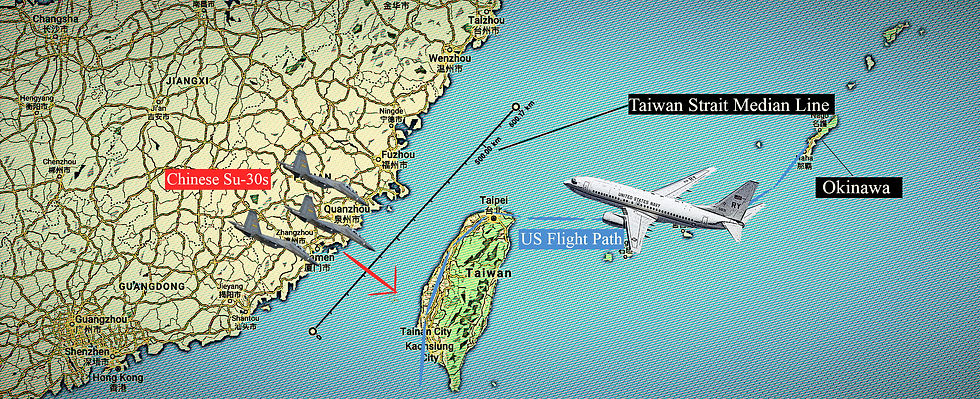Tensions in the Taiwan Strait
- Hunter Williamson
- Jun 14, 2020
- 3 min read

With a US military flight over Taiwan, missile tests, and multiple scramblings of fighter jets by Taipei and Beijing, tensions in the Taiwan Strait briefly flared last week. While Taiwan downplayed the events, the incidents come at a time when relations between the US and China continue to get worse, and both sides are stepping up military operations and exercises in the region. While the situation does not look posed to escalate further for now, they nonetheless reflect the simmering tensions developing between the US and Taiwan on one side and China on the other.
Who’s involved?
United States
China
Taiwan
What happened?
The tension began on Tuesday when a US aircraft departed Okinawa and flew over Taiwan. China - which regards Taiwan as a breakaway province that it is determined to reel back in - responded by sending Su-30 fighter jets toward Taiwan. Taiwan then scrambled its own fighter jets to intercept China’s.
Two days later, Taiwan’s National Chung-Shan Institute of Science and Technology, which produces much of the country’s military equipment and weapons, launched two missiles in what was reportedly a missile defense test. The next day, a Chinese Yun-8 military aircraft entered Taiwanese airspace, prompting Taiwan to again scramble fighter jets. Taiwan downplayed the incident and insisted that it had full control of surrounding areas.
Where did it happen?

The US aircraft, a C-40 transport plane, flew south along Taiwan’s western coast into the Taiwan Strait toward the Bashi Channel before landing in Thailand. China’s Su-30 fighter jets crossed the unofficial boundary in the Taiwan Strait separating Chinese and Taiwanese airspace.

Taiwan launched a Tien Kung-3 surface-to-air missile from Jiupeng and a Tien Kung 2 from Taitung. The Yun-8 that China dispatched out the next day crossed over the unofficial median line mentioned above.

When did it happen?
June 9 - US aircraft flies over Taiwan followed by intrusion of Taiwanese airspace by Chinese fighter jets.
June 11 - Taiwan launches two missiles in purported missile defense test.
June 12 - Chinese military aircraft again enters Taiwanese airspace.
Why?
Taiwan broke away from China in 1949 after a bloody civil war. While Taiwan’s government sees itself as a sovereign state, China does not. Beijing is committed to unifying Taiwan with the mainland. While it would ideally like to achieve this aim through peaceful means, China has not ruled out the possibility of using military force.
Beijing is especially worried about Tsai Ing-wen, Taiwan’s president who is committed to safeguarding her country’s sovereignty and recently called for an expansion of asymmetric warfare capabilities to protect against China. Asymmetric warfare is when a weaker foe uses unconventional weapons against its enemy. In Taiwan’s case, with its smaller military and defense budget, asymmetric warfare involves things like missiles, torpedoes, unmanned drones, and cyber weapons.
Taiwan’s alleged missile test on Thursday involved the Tien-Kung 3 and 2, according to a legislator. Taiwan tested the defense capabilities of the Tien-Kung 3 by firing it at the Tien-Kung 2. While the test was a success, one expert noted that the Tien-Kung 2 is much slower than missiles with which China could strike Taiwan.
Taiwan isn’t the only country worried about China’s advanced missile system. US military officials have also raised alarm about China’s capabilities, and Marine Corps Commandant Gen David Berger has proposed sweeping changes to the force to meet those challenges.
Taiwan was aware of the US military overflight on Tuesday, which China said was a violation of its sovereignty and a threat to peace and stability. The question surrounding Taiwan’s sovereignty is extremely sensitive to China, and many experts fear that Beijing and Washington would go to war if China attempted to use military force in an attempt to reunify the island with the mainland. Under the Trump administration and its focus on security in the Indo-Pacific, the US has increased its military support for Taiwan. Still, Washington does not have formal diplomatic relations with Taiwan like it does with China and most other states. The reason for this has to do with the US wanting to establish formal relations with China in 1979. In place of formal relations with Taiwan, the US created the Taiwan Relations Act. While it does not explicitly require the US to come to Taiwan’s aid in the event of a conflict with China, the US has remained committed to ensuring Taiwan’s security by continuing substantial arms sales. Still, the US is reluctant for Taiwan to make any moves toward formal independence that would anger China and disrupt peace between the two countries. Nonetheless, some experts viewed the US transport flight on Tuesday as a sign of Washington’s commitment to Taiwan.
While last week’s events have the potential to escalate, the situation as of now does not seem likely to get worse. Still, the incidents reflect Washington’s commitment to protecting its interests and those of its allies and partners in the Indo-Pacific, and China’s increasing willingness and confidence to use its military to push back against the United States.



_edited.png)
_edited.png)
_edited.png)
_edited.png)




Comments